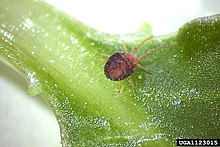Tetranychoidea
| Tetranychoidea Temporal range:
| |
|---|---|

| |
| Spider mite, Bryobia praetiosa (Tetranychidae) | |
| Scientific classification | |
| Domain: | Eukaryota |
| Kingdom: | Animalia |
| Phylum: | Arthropoda |
| Subphylum: | Chelicerata |
| Class: | Arachnida |
| Order: | Trombidiformes |
| Suborder: | Prostigmata |
| Infraorder: | Eleutherengona |
| Superfamily: | Tetranychoidea Donnadieu, 1876 |
Tetranychoidea is a superfamily of mites in the order Trombidiformes. There are about 5 families and more than 2,200 described species in Tetranychoidea.[1][2]
Description[edit]
Mites of this family have the cheliceral bases fused into a structure called a stylophore, which can be moved independently of the subcapitulum and can be retracted into the prodorsum. The movable digits of the chelicerae resemble stylets, being greatly elongated, and their bases are strongly recurved within the stylophore. There is a pair of well-developed peritremes embedded anteriorly on the prodorsum, ending in protruberant enlargements. The true claws of the legs possess tenent hairs. Males possess aedeagi which are used to directly transfer sperm to females.[3]
The individual families can be recognised as follows:
- Allochaetophoridae have only 3 pairs of setae on the prodorsum, instead of 4 pairs as in other families.[4]
- Linotetranidae lack eyes. Also, they are usually colourless and slender in shape.[5]
- Tenuipalpidae lack a palptibial claw complex, a feature present in most other tetranychoids. Also, the body is often flattened and may have well-developed plates.[6]
- Tetranychidae have eyes, 4 pairs of setae on the prodorsum, and a palptibial complex. Its two subfamilies differ in the structure of the empodium, which has tenent hairs in Bryobiinae and lacks them in Tetranychinae.[7][8]
- Tuckerellidae have most dorsal setae expanded and leaf-like. The posterior margin of the body has a row of flagelliform setae.[9]
Ecology[edit]
Tetranychoidea are herbivores. Some species of Tetranychidae, Tenuipalpidae and Tuckerellidae are pests of agricultural and ornamental plants.[3][10]
Families[edit]
These five families belong to the superfamily Tetranychoidea:
- Allochaetophoridae
- Linotetranidae
- Tenuipalpidae
- Tetranychidae (spider mites)
- Tuckerellidae
Gallery[edit]
-
Petrobia (Tetranychidae)
-
Brevipalpus phoenicis (Tenuipalpidae)
-
Tuckerella sp. (Tuckerellidae)
References[edit]
- ^ "Tetranychoidea". Integrated Taxonomic Information System. Retrieved 16 October 2022.
- ^ "Tetranychoidea Superfamily Information". BugGuide.net. Retrieved 2019-04-13.
- ^ a b Meyer, Magdalena K.P. Smith; Ueckermann, E.A. (1997). "A review of some species of the families Allochaetophoridae, Linotetranidae and Tuckerellidae (Acari : Tetranychoidea)". International Journal of Acarology. 23 (2): 67–92. doi:10.1080/01647959708683103. ISSN 0164-7954.
- ^ "Tetranychoidea: Allochaetophoridae". idtools.org. Retrieved September 1, 2023.
- ^ Bagheri, Mohammad; Irani-Nejad, Karim Haddad; Kamali, Karim; Khanjani, Mohammad; Saboori, Alireza; Lotfollahi, Parisa (2008-10-24). "A new species of Linotetranus (Acari : Prostigmata: Linotetranidae) from Iran". Zootaxa. 1914 (1): 65–68. doi:10.11646/zootaxa.1914.1.6. ISSN 1175-5334.
- ^ "Tetranychoidea: Tenuipalpidae". idtools.org. Retrieved September 1, 2023.
- ^ "Tetranychoidea: Tetranychidae, Bryobiinae". idtools.org. Retrieved September 1, 2023.
- ^ "Tetranychoidea: Tetranychidae, Tetranychinae". idtools.org. Retrieved September 1, 2023.
- ^ "Tetranychoidea: Tuckerellidae". idtools.org. Retrieved September 1, 2023.
- ^ Barbar, Ziad; Parker, Bruce; Auger, Philippe (2022-03-30). "Tenuipalpidae and Tetranychidae (Trombidiformes, Tetranychoidea) from Syria with a description of a new species of Bryobia". Acarologia. 62 (1): 58–67. doi:10.24349/6gnq-wcbz.
Further reading[edit]
- Halliday, R.B.; O'connor, O'B.M.; Baker, A.S. (2000). Raven, P.H. (ed.). "Global diversity of mites". Nature and Human Society—the Quest for a Sustainable World. National Academy Press: 192–203. doi:10.17226/6142.
- Krantz, G.W.; Walter, D.E., eds. (2009). A Manual of Acarology. Texas Tech University Press. ISBN 9780896726208.
- Pepato, A.R.; Klimov, P.B. (2015). "Origin and higher-level diversification of acariform mites--evidence from nuclear ribosomal genes, extensive taxon sampling, and secondary structure alignment". BMC Evolutionary Biology. 15: 178. doi:10.1186/s12862-015-0458-2. PMC 4557820. PMID 26330076.
- Zhang, Z.-Q.; Fan, Q.-H.; Pesic, V.; Smit, H.; et al. (2011). Zhang, Z.-Q. (ed.). "Order Trombidiformes Reuter, 1909. In: Zhang, Z-Q. (ed.) Animal biodiversity: an outline of higher-level classification and survey of taxonomic richness" (PDF). Zootaxa. 3148.



